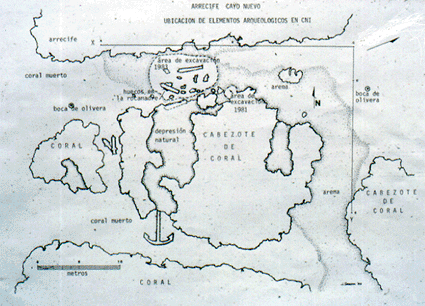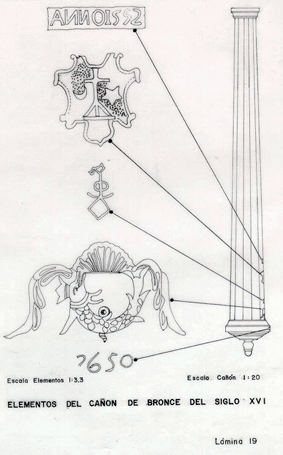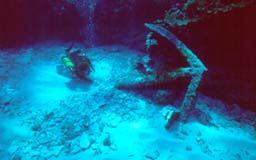Cayo Nuevo Shipwreck, c. 1550
Ricardo Borrero
Country: Mexico
Place: Cayo Nuevo
Coordinates: Lat. ; Long.
Type: Unknown
Identified: No
Dated: c. 1550
History of the shipwreck
Found and reported to the National Institute of Anthropology and History (INAH) in 1979 in the bay of Campeche, Mexico, by two sport divers from Louisiana this Spanish wreck from the middle of the 16th century was surveyed by a joint team from Instituto Nacional de Antropología e Historia (INAH) and the Institute of Nautical Archaeology (INA), under the direction of archaeologist Pilar Luna.

Although no hull remains were found, other than a small piece of timber and some pieces of lead from the calking, a bronze gun bearing the date 15?2, possibly 1552, was found together with five iron guns, two anchors, ceramic fragments, metal concretions and ballast stones.
An anchor lying about 200 m from the shipwreck site may be related to this shipwreck, as a testimony of the last attempt of the crew to avoid the loss of this ship.
Four field seasons were held and the oldest bronze cannon of its kind ever found in the Western Hemisphere dating back to the 16th century was recovered.

In addition to the staff of the then Department of Underwater Archeology of INAH, authorities and researchers from the Southeast Regional Center and other INAH agencies collaborated in this work. The site’s discoverers and several archaeologists and restorers from the Institute of Nautical Archeology (INA), and one from the Department of History at the University of East Carolina also participated. It should be noted that for the four field seasons it had the support of the Secretary of the Navy.
To retrieve the bronze cannon and bring it to the surface, ten barrels filled under water with pressurized air were used as lifting method. When the cannon was being hoisted to be deposited on the deck, hurricane force winds blew, causing the steel cable of the minesweeper 19 to break and the cannon fall 40 meters deep.
The following year, the team returned to locate the canyon, which was found after seven days of search with the help of a group of commercial divers and without any electronic or electromagnetic apparatus to detect it. The lifting operation took 13 hours. First, attempts were made to lift it tied to a balloon capable of holding up to five tons, but it burst as it reached the surface and the cannon fell back to the bottom of the sea. Again, divers went down and tied ropes attached to the crane boom of the Mercurio del Golfo ship, borrowed by PEMEX. In this way, the cannon was finally lifted and deposited on the deck, where preventive measures for its conservation were immediately applied.
Cargo
Metal, ceramic, and some ballast stones were also recovered. Small fragments of the lining of the ship’s hull were found, using a proton magnetometer and SCUBA diving. There were also pieces such as handmade bronze pins, droplets of mercury, an almost complete bronze candlestick, a canon iron bullet that does not correspond to the caliber of the cannons found there, a very small piece of wood and fragments of lead.
Ballast
Ballast stones were sampled.
Anchors
 An iron anchor was recovered a few meters away from where the bronze cannon was originally found. The question that arises is whether the cannons and anchor were part of a shipwreck that occurred in the area or got there because the crew dumped them in a moment of danger. Three iron anchors were found in another area of the reef. The anchors probably belonged to an 18th century vessel.
An iron anchor was recovered a few meters away from where the bronze cannon was originally found. The question that arises is whether the cannons and anchor were part of a shipwreck that occurred in the area or got there because the crew dumped them in a moment of danger. Three iron anchors were found in another area of the reef. The anchors probably belonged to an 18th century vessel.
Guns
In addition to the bronze cannon, a cannon was recovered nearby the originall location of the bronze cannon. Elsewhere on this reef 25 iron cannons, three iron anchors, and several lead-sized ammunitions were found. The iron pieces were covered with coral concretions. The site was located with the magnetometer and the metal detector. The inscription on one of the cannons showed that it was another shipwreck, dating to the 18th century.
References
Luna, Pilar, 1979. Informe sobre los trabajos arqueologico maritimos realizados en el arrecife Cayo Nuevo, Campeche. Typed Report, INAH.
Luna, Pilar, 1980. Informe sobre los trabajos de prospeccion arqueologica y de recuperacion de elementos pertenecentes a un naufragio del siglo XVI en el arrecife Cayo Nuevo, sonda de Campeche. Typed Report, INAH.
Smith, Roger “Treasure ships of the Spanish Main: The Iberian-American Maritime Empires” in Ships and Shipwrecks of the Americas, Ed. by George Bass, T&H, 1988 :87
